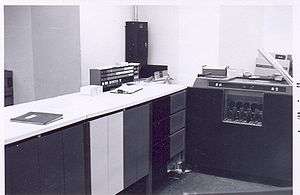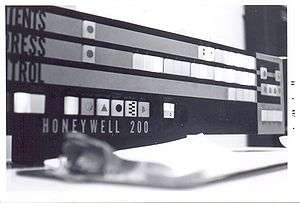Honeywell 200
The Honeywell 200 was a character-oriented[1]:70C-4S0–01n two-address commercial computer introduced by Honeywell in the early 1960s, the basis of later models in Honeywell 200 Series, including 1200, 1250, 2200, 3200, 4200 and others,[2][3] and the character processor of the Honeywell 8200 (1968).[4][5][6]


Introduced to compete with IBM's 1401, the H200 was two or three times faster and, with software support, most of the time[7][8] could execute IBM 1401 programs without need for their recompilation or reassembly. The Liberator marketing campaign exploited this compatibility, and was credited in later Honeywell publicity statements with stalling the sales of IBM 1401 machines. Honeywell claimed an initial rush of hundreds of orders for the H200 that itself stalled when IBM countered[9][10] with a marketing emphasis on their System 360 product range that was then under development.
Architecture
As designed by Director of Engineering William L. Gordon,[11][12] the H200 memory consisted of individually addressed characters, each composed of six data bits, two punctuation bits and a parity bit.[1]:70C-4S0–01a The two punctuation bits recorded a word mark and an item mark, while both being set constituted a record mark. The item bit permitted item moves and record moves in addition to word moves (move successive characters one-by-one starting at the addresses given in the instruction, stopping when the relevant punctuation mark was found set in either field).
An instruction consisted of a one-character op-code, up to two operand addresses and an optional single character variant. Usually the op-code character would be word-marked, confirming the end of the previous instruction. An item-marked op-code would be handled differently from normal, and this was used in the emulation of IBM 1401 instructions that were not directly compatible. The first three bits of an operand address could designate one of six index registers that occupied the first 32 addressable memory locations. The other two possible bit patterns indicated no indexing, or indirect addressing.[13][14]
A Change Address Mode (CAM) instruction switched between 2-, 3- and 4-character address modes. The address mode specified the number of characters needed for each operand address in instructions.
A Change Sequence Mode (CSM) instruction stored the next instruction address in a memory location and loaded the instruction counter from another memory location. This provided a simple switch between threads within a program, similar to the sequence/cosequence behaviour of the Honeywell 800 series.
While the H200 supported operation with just a console, card reader and punch like the IBM 1401, the generic Input-Output instructions also supported line printers and magnetic tape drives.
IO instructions left punctuation bits unchanged, reading or writing only data (and parity) bits into memory, and terminating on any record mark encountered. A record mark could be placed at the end of an input buffer to prevent any buffer overflow, a problem that was to persist in many other systems into the 21st century.
The 200-series IO instructions were a Peripheral Data Transfer (PDT) and a Peripheral Control and Branch (PCB)[13] that explicitly implemented asynchronous IO. The PDT specified a device address, a buffer address and the transfer operation to be started, while the PCB specified a device address, and set the operating mode or tested the status of the device. Both used the format Op-code Address I/O unit address Variant.
Software
The native assembly language was named Easycoder.
The Easycoder assembler generated an object file as a binary card deck that could be punched to cards or written to magnetic tape instead. The object file began with a bootstrapping routine so that each program could be loaded into memory, from card reader or magnetic tape, using a boot command from the console.
Compilers
Although Honeywell placed strong emphasis on the use of COBOL,[1]:p.70C-480–01m it also supported FORTRAN and RPG.[1]:70C-480–01i
Systems software
The H200 was commonly used as a spooling computer associated with a larger Honeywell 800 series machine. The H1800-II consisted of an H1800 mainframe equipped only with magnetic tape drives and an online adaptor (OLA) connection to a satellite H200 to simulate a card reader for reading low volumes of job control cards. The LINK program running on the H200 handled the OLA,[1]:70C-480–01hh[15] copied punched cards or punched paper tape to magnetic tape, and copied records from magnetic tape to card punch or to line printer.
In popular culture
In 1965 as part of the H200 promotion in the UK, the subsidiary Honeywell Controls Limited commissioned the artist Rowland Emett to construct a whimsical mechanical sculpture called The Honeywell Forget-me-not Computer as part of the company's exhibit at the Business Equipment Exhibition.
Honeywell 200 consoles featured in the graphic design of Len Deighton's Billion-Dollar Brain book jacket and also figured as part of the hall-sized supercomputer complex in the 1967 movie of the book starring Michael Caine and Karl Malden.[16] These promotions, plus an Emett calendar, originated in the UK and were the inspiration of Don Hatton, the publicity manager of Honeywell Controls Limited Electronic Data Processing division.
The Honeywell 1200 was shown being used by police in Dario Argento's movie from 1970, The Bird with the Crystal Plumage.
See also
References
- "Honeywell 200".
- Series 200 installation dates:
- computersAndAutomation :: Computer Census 1962-74. Jul 1974. p. 41 (301).
- Models in Series 200; model 200 was transistorized, later models used IC
- "CHARACTERISTICS OF THE SERIES 200 PROCESSOR MODELS". Honeywell Series 200 and 2000 (PDF). Apr 1974. pp. 70C-480-01b - 70C-480-01c (2-3).
- Harper, Charles A. (1969). Handbook of electronic packaging. McGraw-Hill. pp. 12–4.
- The European Computer Users Handbook. Computer Consultants. 1968. pp. 1–130.
- New "Honeywell 8200" computer & other equipment inspected by Sir John Goodsell (Photo), 1970, retrieved 2019-02-26
- Strohl, Elaine K.; Kilgore, Yvonne H.; Sass, Margo A.; Goldstein, Gordon D. (October 1965). "COMPUTERS AND DATA PROCESSING, NORTH AMERICA: 4. Honeywell, Inc., H-8200, Wellesley, Massachusetts". DIGITAL COMPUTER NEWSLETTER. OFFICE OF NAVAL RESEARCH ARLINGTON VA. 17 (4): 6–9.
- HATCH JR., THEODORE F.; GEYER, JAMES B. (Dec 1968). "Hardware/software Interaction on the Honeywell Model 8200". Managing Requirements Knowledge, International Workshop on(AFIPS): 891. doi:10.1109/AFIPS.1968.108.
- H8200 Hardware Reference Prelim. Honeywell. Aug 1967. Archived (PDF) from the original on 1967.
- Terry, Edward (2012-06-07). "Using Liberator". The IBM 1401 Demo Lab and Restoration Project Computer History Museum. 1401 Competition, mainly the Honeywell 200 with Liberator software. Archived from the original on 2020-02-12. Retrieved 2020-02-12.
- ""Most of the time ... a successful “Liberation”. If not, then ... patching the 1401 object deck before conversion."
- Dirk de Wit (1994). The Shaping of Automation: A Historical Analysis of the Interaction. ISBN 9065504141.
- "IBM System 360 came as a response to the introduction of the Honeywell 200."
- "Easycoder survivors". June 8, 2012.
- "... the late Dr. William L. Gordon, who was the head of the team at Honeywell that designed the H200.
- Honeywell 200: programmers' reference manual. Honeywell Information Systems, inc. 1963.
- "OPTIONAL FORMS OF ADDRESSING Two optional forms of addressing are available with the Honeywell 200: indirect addressing and indexed addressing."
- "On-Line Adapter (connects a Series 200 processor to a Honeywell 800 or 1800)"
- "The Billion Dollar Brain - Honeywell H200 Computer (YouTube)". April 14, 2010.
External links
- "Honeywell Series 200". Archived from the original on May 25, 2006. (in French and English)